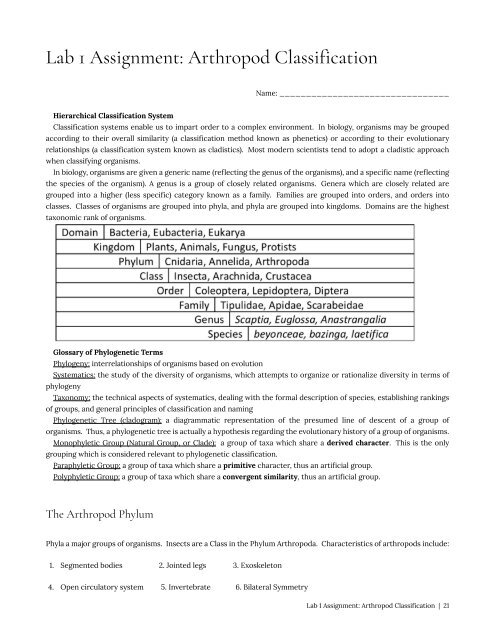Entomology 311 Lab Manual - 1st Edition, 2019
Entomology 311 Lab Manual - 1st Edition, 2019
Entomology 311 Lab Manual - 1st Edition, 2019
Create successful ePaper yourself
Turn your PDF publications into a flip-book with our unique Google optimized e-Paper software.
<strong>Lab</strong> 1 Assignment: Arthropod Classification<br />
Name: ________________________________<br />
Hierarchical Classification System<br />
Classification systems enable us to impart order to a complex environment. In biology, organisms may be grouped<br />
according to their overall similarity (a classification method known as phenetics) or according to their evolutionary<br />
relationships (a classification system known as cladistics). Most modern scientists tend to adopt a cladistic approach<br />
when classifying organisms.<br />
In biology, organisms are given a generic name (reflecting the genus of the organisms), and a specific name (reflecting<br />
the species of the organism). A genus is a group of closely related organisms. Genera which are closely related are<br />
grouped into a higher (less specific) category known as a family. Families are grouped into orders, and orders into<br />
classes. Classes of organisms are grouped into phyla, and phyla are grouped into kingdoms. Domains are the highest<br />
taxonomic rank of organisms.<br />
Glossary of Phylogenetic Terms<br />
Phylogeny: interrelationships of organisms based on evolution<br />
Systematics: the study of the diversity of organisms, which attempts to organize or rationalize diversity in terms of<br />
phylogeny<br />
Taxonomy: the technical aspects of systematics, dealing with the formal description of species, establishing rankings<br />
of groups, and general principles of classification and naming<br />
Phylogenetic Tree (cladogram): a diagrammatic representation of the presumed line of descent of a group of<br />
organisms. Thus, a phylogenetic tree is actually a hypothesis regarding the evolutionary history of a group of organisms.<br />
Monophyletic Group (Natural Group, or Clade): a group of taxa which share a derived character. This is the only<br />
grouping which is considered relevant to phylogenetic classification.<br />
Paraphyletic Group: a group of taxa which share a primitive character, thus an artificial group.<br />
Polyphyletic Group: a group of taxa which share a convergent similarity, thus an artificial group.<br />
The Arthropod Phylum<br />
Phyla a major groups of organisms. Insects are a Class in the Phylum Arthropoda. Characteristics of arthropods include:<br />
1. Segmented bodies 2. Jointed legs 3. Exoskeleton<br />
4. Open circulatory system 5. Invertebrate 6. Bilateral Symmetry<br />
<strong>Lab</strong> 1 Assignment: Arthropod Classification | 21


















